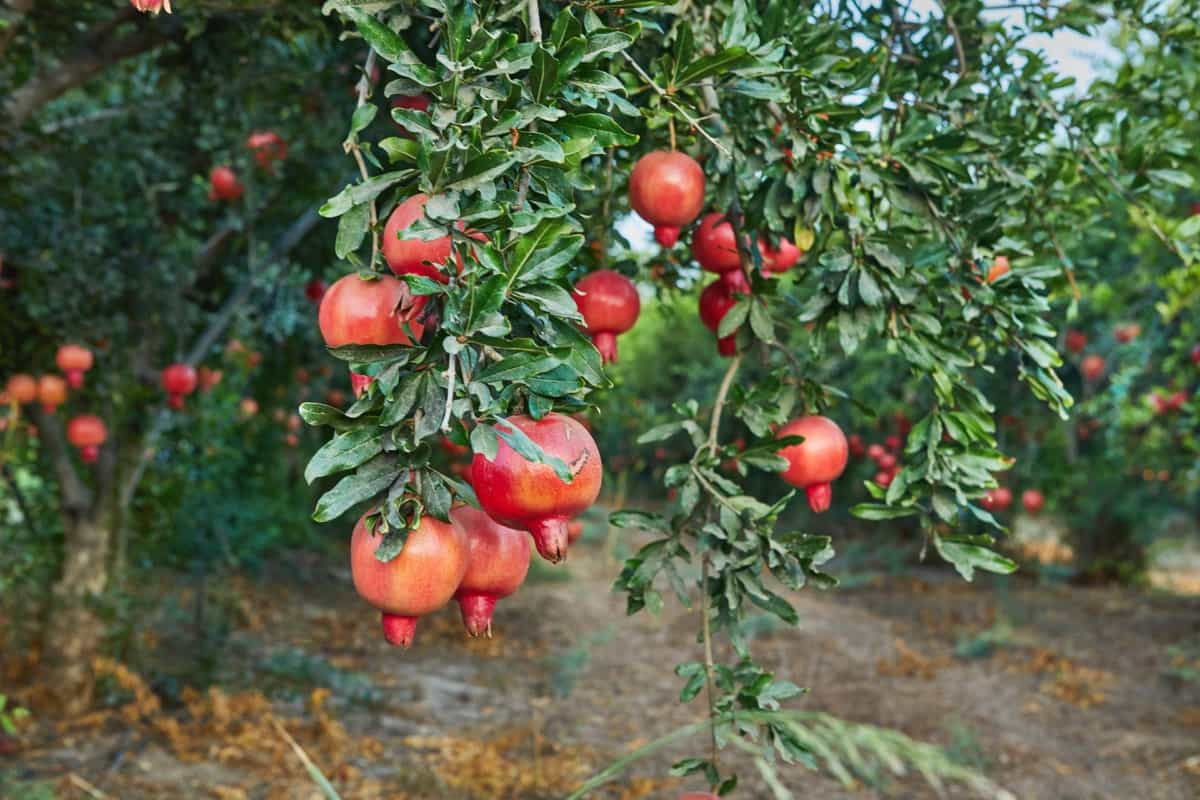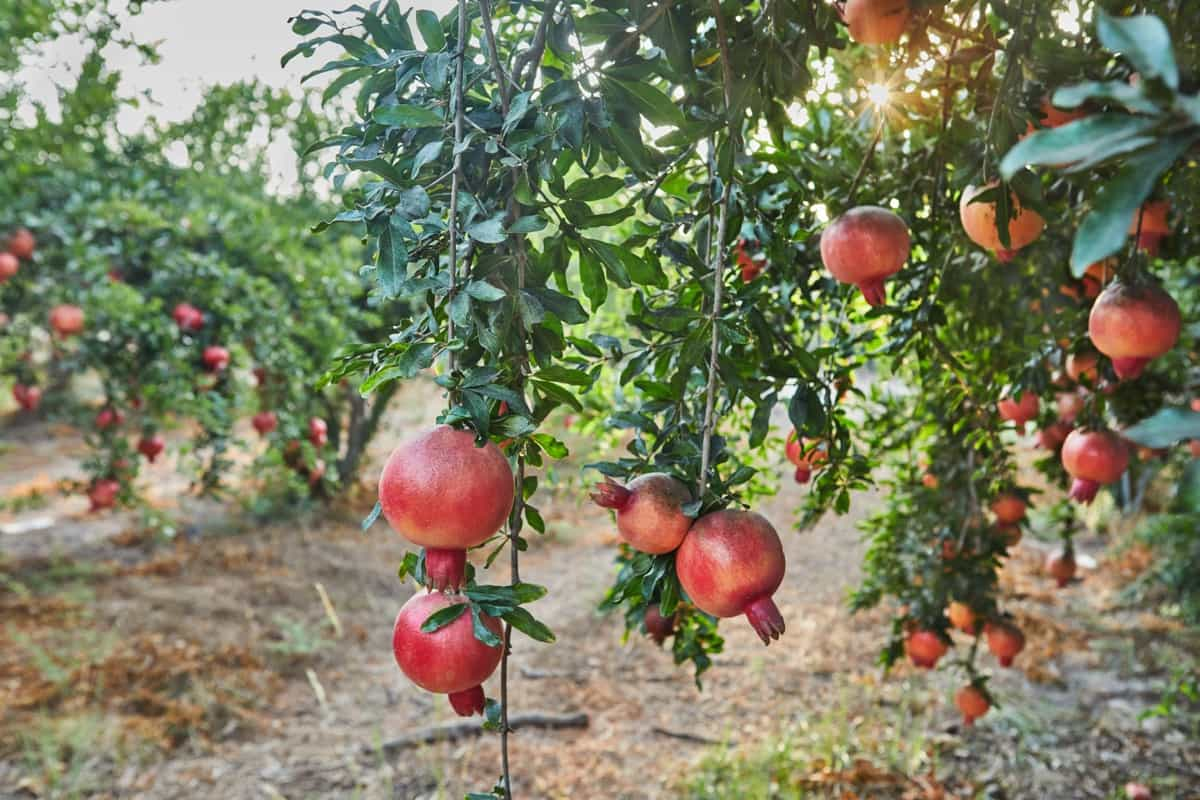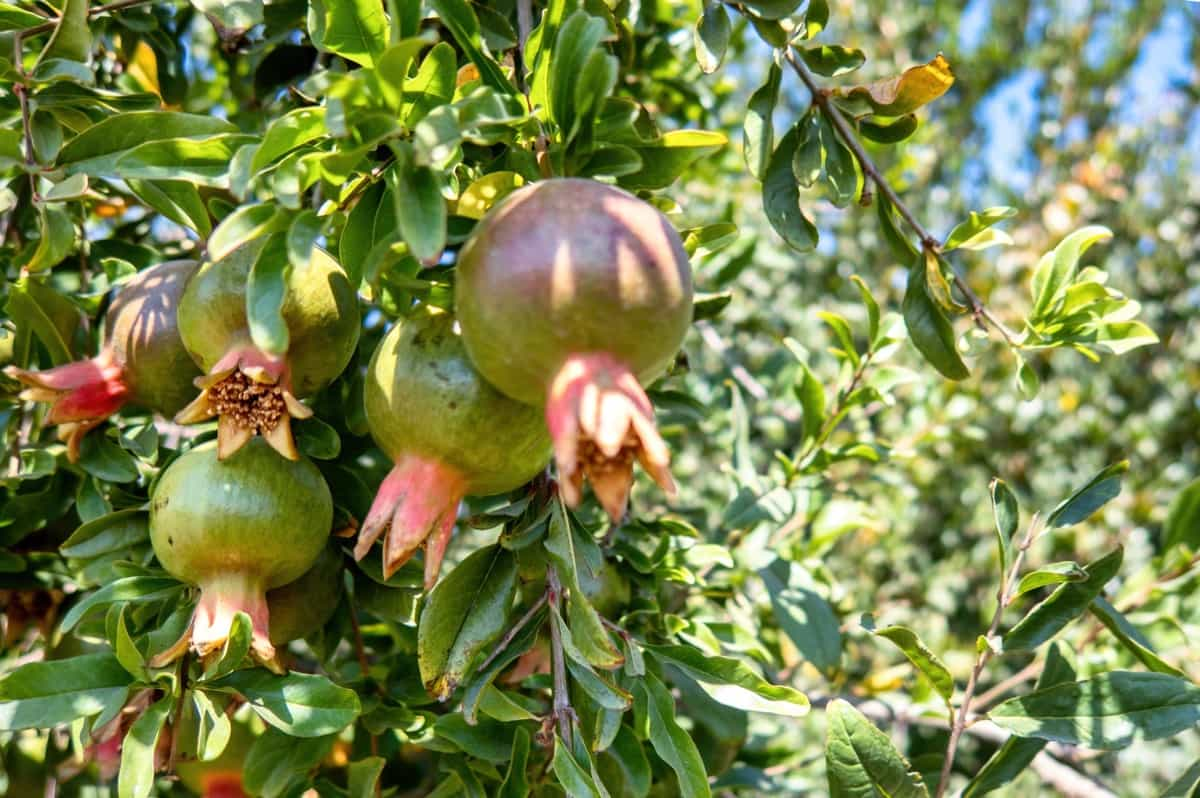Welcome to the world of pomegranate farming! This analysis delves into the economics and project report of establishing a pomegranate farm on a 1-acre land. We’ll explore the costs of setting up the farm, including land preparation, infrastructure development, and procuring high-quality saplings. Additionally, we’ll examine the ongoing expenses of cultivation, such as irrigation, fertilizers, and labor. Finally, we’ll assess the potential profitability by considering market prices, yields, and the return on investment.

What is Pomegranate Farming?
Pomegranate farming refers to the cultivation of pomegranate trees for commercial purposes. Pomegranate trees are deciduous and can grow up to 20 feet tall. They require a Mediterranean climate with hot summers and cool winters. Pomegranate trees start bearing fruit after 2-3 years of planting. The average lifespan of a pomegranate tree is around 15-20 years.
Overview of Pomegranate Trees: Biology, Production, and Uses
- Pomegranate (Punica granatum) is a deciduous shrub native to the Mediterranean region, introduced to Spanish America in the late 16th century and California in 1769.
- The fruit is in season from March to May in the Southern Hemisphere and September to February in the Northern Hemisphere.
- Pomegranates are versatile and used in various forms, such as intact sarcotestas, juice, baking, cooking, garnishes, smoothies, cocktails, and wine.
- Widely cultivated across regions like the Middle East, Caucasus, Africa, Iran, the Indian subcontinent, Central Asia, Southeast Asia, and the Mediterranean Basin.
- Pomegranate trees have spiny branches, can reach heights of 5 to 10 meters (16-33 feet), and live for a long time.
- Glossy, narrow oblong leaves and bright red flowers with three to seven petals characterize pomegranate trees.
- The fruit has a red-purple husk comprising an outer hard pericarp and an inner spongy mesocarp with seed-containing chambers.
- A pomegranate can have 200 to about 1,400 seeds, a round shape, 5-12 cm diameter, and a thick, reddish husk.
- Pomegranate juice is sour due to its low pH and high polyphenol content, with pigmentation from anthocyanins and ellagitannins.
- Cultivated for fruit production and as ornamental trees and shrubs, pomegranate trees tolerate drought and moderate frost.
- Insect pests include butterflies, leaf-footed bugs, fruit flies, and ants, while propagation is commonly done through cuttings to maintain genetic consistency.
- India and China produce the most pomegranates worldwide, with Iran, Turkey, Afghanistan, the United States, Iraq, Pakistan, Syria, and Spain following. Chile, Peru, Egypt, Israel, India, and Turkey provided pomegranates to the European market.
Market and Demand for Pomegranate Farming
The global pomegranate and pomegranate arils market, valued at USD 8.2 billion in 2018, is expected to reach USD 23.14 billion by 2026, at a CAGR of 14.0%. The market is increasing demand for processed pomegranate products, particularly juice, and cosmetics. Government initiatives, such as subsidies and training for farmers and exporters, are expected to create opportunities for players in the target market.
In case you missed it: 9 Causes of Dying Pomegranate Tree and How to Fix It?

Additionally, the North American and Europe region focuses on reducing end-product costs, with automation aiding manufacturers in improving processes and reducing costs. The pomegranate powder segment is expected to dominate the market, with a CAGR of over 4.8%. The pomegranate juice concentrate segment is expected to account for the second highest share in revenue, as it is used in cooking as a concentrated syrup and fresh juice.
Best High-Yielding Variety for Commercial Pomegranate Farming
| Variety | Origin/Distribution | Special Characteristics |
| Chandler | Worldwide | Large fruit size, vibrant yellow color, sweet flavor |
| Kao Pan | Thailand | Large round fruits, thick rind, sweet-tart taste |
| Borneo Red | Malaysia | Vibrant red flesh, sweet and tangy flavor |
| Nanfeng Honey | China | Sweet taste, honey-like fragrance, thin rind |
| Khasi Papeda | India | Tolerance to pests and diseases, unique sour taste |
| Thong Dee | Thailand | Juicy, aromatic, slightly acidic taste, thin rind |
| Kao Phuang | Thailand | Distinctive shape, pale yellow color, sweet taste |
Pomegranate Farming Economics and Project Report
Pomegranate farming can be economically rewarding with careful planning, efficient management, and a market-oriented approach. It is essential to consider factors like variety selection, cost optimization, market analysis, and continuous monitoring to ensure successful and profitable pomegranate farming.
- Initial Investment: The initial investment includes land acquisition, infrastructure development, irrigation systems, planting material, fertilizers, and labor costs.
- Cost of Cultivation: The cost of cultivation involves expenses for land preparation, planting, irrigation, fertilization, pest and disease control, pruning, and harvesting.
- Yield and Production: Pomegranate trees yield fruit in the third or fourth year after planting. The average yield per acre can range from 8 to 12 tons, depending on factors like variety, climate, and management practices.
- Market Demand: Pomegranates have a high demand in domestic and international markets due to their health benefits and culinary uses. It is essential to identify potential buyers and establish market linkages.
- Revenue and Profit: The revenue from pomegranate farming depends on the yield, market price, and marketing strategy. With proper management, a well-established pomegranate orchard can yield significant profits.
- Project Viability: Conducting a feasibility study and creating a detailed project report helps assess the financial viability of pomegranate farming. It involves estimating costs, analyzing potential returns, and evaluating risks.
- Government Support: Various government schemes and subsidies are available to support pomegranate farmers, including financial assistance, training programs, and infrastructure development.
In case you missed it: How to Increase Female Flowers in Pomegranate: Explained in 10 Simple Steps

Project Report of 1-Acre Pomegranate Farming: Cost and Profit Analysis
| Expense | Cost (USD) | Cost (INR) |
| Land preparation | $350 | 25,000 |
| Plants | $225 | 16,000 |
| Fertilizer and Manure | $350 | 25,000 |
| Irrigation Setup | $700 | 50,000 |
| Irrigation | $70 | 5,000 |
| Labor | $630 | 45,000 |
| Total | $2,325 | 1,66,000 |
| Weeding (constant yearly) | $350 | 25,000 |
- Initial investment for a 1-acre pomegranate farm: Approximately USD 2,200 or INR 1,66,000.
- Land preparation and infrastructure development cost: USD 330 or INR 25,000.
- Expenses in planting and cultivating pomegranate trees: USD 210 or INR 16,000 for high-quality plants, and USD 330 or INR 25,000 for fertilizer and manure.
- Average cost of irrigation systems and water management: USD 660 or INR 50,000 for irrigation setup, and USD 66 or INR 5,000 for irrigation.
- Cost of procuring high-quality pomegranate saplings: Varies from USD 0.05 to USD 0.66 or INR 4 to INR 50 per plant.
- Ongoing expenses for fertilizers, pesticides, and inputs: USD 590 or INR 45,000 for labor and weeding.
- Labor required for maintenance and harvesting: USD 590 or INR 45,000.
Cost of Cultivation of 1-Acre Pomegranate Farming
- The initial investment required for a 1-acre pomegranate farm includes land preparation and infrastructure development, which costs approximately 25,000 rupees.
- The expense for procuring pomegranate plants is around 16,000 rupees. Fertilizers and manure for the farm amount to 25,000 rupees, while the irrigation setup costs 50,000.
- Ongoing irrigation expenses are estimated at 5,000 rupees. Labor costs for maintenance and harvesting amount to 45,000 rupees.
- Considering these expenses, the total investment for a 1-acre pomegranate farm sums up to 1,66,000 rupees.
- Additionally, there is a constant weeding expense of 25,000 rupees per year. The cost of pomegranate plants can vary from 7 to 80 rupees per plant, depending on the availability and variety.
Profits and Return to Investment from 1-Acre Pomegranate Farming
- Pomegranate plants start producing 5-10 kg of fruits in the 4th year, increasing to 25 kg in the third year and potentially reaching 50 kg gradually.
- With a lifespan of up to 50 years, pomegranate trees offer long-term benefits for farmers. Approximately 200-300 plants can be grown on one acre of land, yielding 8 tonnes per acre.
- While pomegranate farming can be profitable, it also incurs expenses such as plant propagation, purchasing quality plants, land preparation, weeding, labor, irrigation setup, and harvesting costs.
- Farmers can expect increasing profits each year despite these costs, with a potential turnover of up to 4,50,000 INR per year in the 6th year.
In case you missed it: 9 Common Problems with Ridge Gourd Plants: Treatment and Solutions

Conclusion
1-acre pomegranate farming involves initial investments in land preparation, infrastructure, plants, irrigation, labor, and ongoing expenses for inputs and maintenance. However, proper care can increase profits over the years, making it a potentially profitable venture.
- Feed Your Flock for Less: Top 10 Tips to Save on Chicken Feed
- Ultimate Guide to Ossabaw Island Hog: Breeding, Raising, Diet, and Care
- Hatching Answers: The Top 10 Reasons Your Chickens Aren’t Laying Eggs
- Eggs and Economics: Breaking Down the Cost of Raising Backyard Chickens
- Defend Your Greens: Proven Methods to Keep Iguanas Out of Your Garden
- Ultimate Guide to Cinnamon Queen Chicken: A Comprehensive Guide for Beginners
- Ultimate Guide to California Tan Chicken: Breeding, Raising, Diet, Egg-Production and Care
- Ultimate Guide to Marsh Daisy Chicken: Breeding, Raising, Diet, and Care
- 10 Types of Chicken Farming Businesses You Can Start for Profits